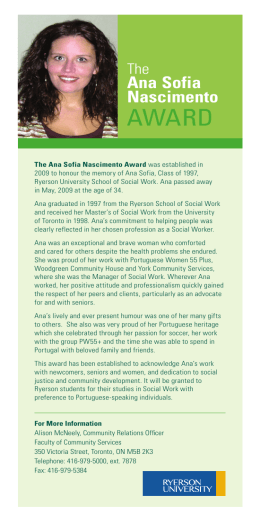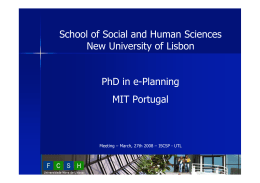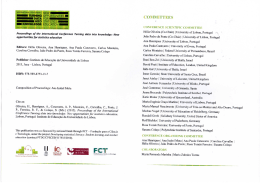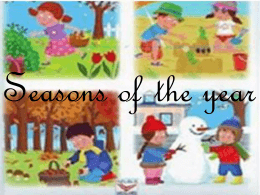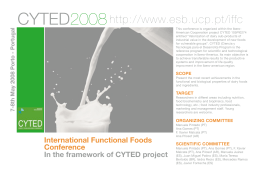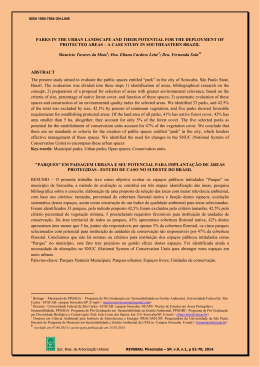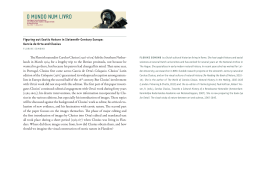ISSN 1980-7694 ON-LINE THE ASSESSMENT OF FLORISTIC COMPOSITION, SIZE, HEALTH AND CURRENT TREE CONSERVATION OF THE INTERNATIONAL PARK IN SANT’ANA DO LIVRAMENTO BRAZIL AND RIVERA URUGUAY Ana Claudia Bentancor Araujo1; Cibele Rosa Gracioli2; Edenir Luis Grimm3; Solon Jonas Longhi4 ABSTRACT This study aimed to evaluate quantitatively and qualitatively the vertical composition of the International Park at Sant’ana do Livramento/BR and Rivera/UY, to identify, classify and present a list of species with their families and occurrences, and to evaluate plant health and tree management procedures required. All existing individuals with BHD greater than or equal to 15.7 cm were inventoried. At this stage, we recorded data for the individuals regarding BHD, height, origin, plant health and the need for light or heavy pruning. In the Park, 300 trees belonging to 24 families were identified, with a small rate of native species (31%) and a high percentage of exotic trees (69%). Regarding the number of individuals, Cupressaceae was the most important family, followed by Moraceae, Bignoniaceae, Oleaceae, Pinaceae and Fabaceae families. The most occurrences were found for individuals of the species Ligustrum japonicum followed by Ficus microcarpa Chamaecyparis lawsoniana and Handroanthus heptaphyllus. A poor phytosanitary condition was observed in 18.27% of the individuals and 81.73% was in good health condition. Regarding the individuals in the worst phytosanitary condition, Magnolia grandiflora, Ligustrum japonicum and Handroanthus heptaphyllus were the most infested by mistletoe. Keywords: urban forestry, floristic composition, landscaping. AVALIAÇÃO DA FLORÍSTICA, DO PORTE E DA FITOSSANIDADE ATUAL DA ARBORIZAÇÃO DO PARQUE INTERNACIONAL EM SANT’ANA DO LIVRAMENTO/RIVERA, BRASIL/URUGUAI RESUMO O presente estudo teve como objetivo a avaliação quantitativa e qualitativa da composição vertical do Parque Internacional localizado no município de Sant’Ana do Livramento/BR e Rivera/UY, visando identificar, classificar e apresentar uma listagem das espécies arbóreas encontradas com suas respectivas famílias e número de ocorrência, além de avaliar o estado fitossanitário e a necessidade de manejo das árvores. Foram inventariados todos os indivíduos existentes com circunferência à altura do peito (CAP) maior ou igual a 15,7cm. Nessa etapa foram anotados e medidos dados referentes ao indivíduo como: CAP, altura total, origem, estado fitossanitário e necessidade de poda leve ou pesada. Foram inventariadas 300 árvores pertencentes a 24 famílias. Verificaram-se um baixo índice de espécies nativas existentes no Parque, 31%, e um alto percentual de árvores exóticas, 69%. Quanto ao número de indivíduos, destacam-se a família Cupressaceae, seguida pela Moraceae, Bignoniaceae, Oleaceae, Pinaceae e Fabaceae. Dentre os indivíduos encontrados as espécies Ligustrum japonicum seguida por Ficus microcarpa, Chamaecyparis lawsoniana e Handroanthus heptaphyllus foram as mais abundantes. Foram encontrados 18,27% indivíduos com o estado fitossanitário ruim e 81,73% indivíduos em bom estado. Dos indivíduos em mau estado fitossanitário destacam-se Magnolia grandiflora, Ligustrum japonicum e Handroanthus heptaphyllus que se encontram infestadas por erva-de-passarinho. Palavras-chave: silvicultura urbana, composição florística, paisagismo. 1 Engenheira Florestal, MSc, Professora do Instituto Federal Farroupilha. E-mail: [email protected] Engenheira Florestal, Dra, Professora da Universidade do Pampa (Unipampa). E-mail: [email protected] 3 Engenheiro Agrônomo, Dr, Professor do Instituto Federal Farroupilha. E-mail: [email protected] 4 Engenheiro Florestal, Dr, Professor do Dept. de Eng. Florestal da Univ. Federal de Santa Maria (UFSM). E-mail: [email protected] 2 Soc. Bras. de Arborização Urbana REVSBAU, Piracicaba – SP, v.7, n.1, p. 66-74, 2012 INTRODUCTION Along history, we have observed different perceptions organization such as the electric and telephone wiring as towards trees and their functions in the environment. well as water and sewage systems (MENESES et al., From the disordered extraction in recent centuries to the 2003). Thus, in order to introduce trees to urban spaces significant scarcity for green areas as currently observed that do not inflict future problems, an adequate planning not only in urban environments, but in rural areas as well must be adopted considering the cultural and historic (BRUN; BRUN, 2006). The authors emphasize that the aspects of the local population, as well as their needs and disordered growth of cities has caused serious problems aspirations taking into account the physical space such as the concentration of air pollutants, formation of available (PRASS, 2004). heat islands, visual and sonic pollutions due to the lack of Dantas et al. (2004) highlight that planning urban planning for urban growth. afforestation is a sine qua non condition for urban growth as Thus, vegetation offers proved benefits such as the a means to prevent damages to the environment. Urban welfare provided to the population, better aesthetic afforestation is essential for a healthy environment, once it effect, shades for pedestrians and vehicles, sound barrier, directly affects the welfare of the population because of the reduction of rain impact to the soil and rainwater runoff numerous benefits that urban trees provide. and preservation of local fauna (PIVETTA; SILVA The International Park, belonging to the municipality of FILHO, 2002). According to Paiva and Gonçalves Sant’Ana do Livramento/Brazil and Rivera/Uruguay was (2002), urban afforestation contributes to the harmony of created on February 26, 1943, and consists of green area landscapes breaking the sharp lines of the concrete harmoniously enjoyed by the local population and from constructions and creating smooth and natural lines. neighboring cities, constituting a unique case in the world. Places with intense movement of pedestrians, when well This park is part of the urbanistic-architectonic complex of afforested, ensure a more pleasant environment with both municipalities, becoming a place of high ecological, more ecological, social and economical benefits (MELO, scientific, historic, cultural and patrimonial interests. 2005). In this context, studies to assess the current floristic For Demattê (1997), urban afforestation always maintains condition of the park present basis for the implementation a little of the original flora of cities on their squares, of parks and preservation sites. Squares are meeting places procedures. whose main function is the promote community life. Therefore, They are green areas with dimensions, in general, quantitatively and qualitatively the vertical composition 2 preservation the and current development study aimed management to assess between 100 m and 10 ha. However, it is not possible to of the International Park to identify, classify and present a standardize squares, in terms of area, without knowing list of tree species with their respective families number the areas surrounding them. of occurrences in the park, in addition to an evaluation of Nevertheless, urban afforestation is not planned and is the phytosanitary conditions and management procedures carried out by unqualified personnel that can cause direct required for the trees. negative consequences to some elements of urban THE ASSESSMENT OF FLORISTIC… Soc. Bras. de Arborização Urbana REVSBAU, Piracicaba – SP, v.7, n.1, p. 66-74, 2012 67 MATERIALS AND METHODS Study area The study was carried out at the International Park origin, phytosanitary condition and need for light or situated between the municipalities of Sant’Ana do heavy pruning. o 48’ 31” S and The tree origin was classified as native or exotic. The longitude 55º 22’ 33”O) and Rivera, in Uruguay (latitude height was classified as follows: small (H≤6m), medium 30 54’ 20’’ S and longitude 55 33’ 02’’O). (6.1m≤H≤10m) and large (H>10m). The need for The park covers circa 3 hectares and the municipalities management was evaluated individually and we analyzed are approximately 208 meters above sea level. The the need for the following actions: light pruning, climate in the region is classified as humid temperate in (removal of branches that affect the natural conformity of the summer, with the annual temperature ranging from the tree); heavy pruning (removal of a large part of the 12.1°C and 18°C and the annual precipitation of around crown due to some damage the trees may cause to other 1,388 mm (MALUF, 2000). According to Streck et al. species or to park-goers); phytosanitary control (presence (2008), this region is characterized as Ultisols Bruno- of visible pests or diseases through damages caused to Gray Alytic abrupt. several parts of the trees) and vegetation removal (dead Livramento, in Brazil (latitude 30 individuals or with irrecoverable condition). The most common species were identified in loco and the Vegetation sampling others were, then, identified in the Herbarium of the We inventoried all trees existing in the International Park Department in the municipalities of Sant’Ana do Livramento/BR and Universidade Federal de Santa Maria/Rio Gande do Sul Rivera/UY with BHD greater or equal to 15.7 cm. At this state - Brazil. The botanical families were classified in stage, we recorded and measured data regarding: BHD, accordance to Angiosperm Phylogeny Group (APG II). of Forest Science (HDCF) of the total height using the hypsometer electronic Vertex III, RESULTS AND DISCUSSIONS Floristic analysis We surveyed 300 trees in the International Park, We observed a few occurrences of native species in the including one dead tree and one unidentified. The species park (25%) and many occurrences of exotic species belong to 24 families of Fabaceae, with five genera and (69%). five species and Pinaceae, with five genera and five The high percentage of occurrence of exotic species species, followed by Arecaceae, with 4 genera and five found in the park is not ideal, because according to species; Moraceae, with two genera and four species; Sanchotene (1985), Blum et al. (2008) and Guia et al. Bignoniaceae, with two genera and three species and (2008), we should prioritize the use of species native to Cupressaceae, with two genera and three species (Table the region because, besides the preservation of species, 1). These are the most important families in the floristic this procedure also provides a better physical-graphic composition of the park and are represented by 20 genera balance, incorporating elements that integrate the urban and 25 species. landscape to the landscape in the region. The improvement of green urban areas with the use of native species of landscape features shows an expressive Ana Claudia Bentancor Araujo et al.. 68 Soc. Bras. de Arborização Urbana REVSBAU, Piracicaba – SP, v.7, n.1, p. 66-74, 2012 gain of valuation and can contribute, in part, to species The total basal area found in the site was 32.7618 m2/ha conservation. and the species Cunninghamia lanceolata had more The native species present resistance to stress factors of occurrences, followed by Chamaecyparis lawsoniana, the urban environment, climatic adaptability, survival Handroanthus heptaphyllus and Cupressus sempervirens capacity and development in urban sites, in addition to (Table 1). These results show that large-sized individuals resistance to pests and diseases (GUIA et al., 2008). represent these species in the park. Among the individuals found in the park, the Ligustrum Santamour Júnior (2002) recommends that the same japonicum stands out with 29 individuals, occurring in all species should not exceed 10% of the total, 20% of a areas of the park, followed by Ficus microcarpa, with 27 genus and 39% of a botanical family, because diversity of individuals, 23 trees in urban landscape is required to ensure maximum individuals and Handroanthus heptaphyllus with 21 protection against pests and diseases. We observed that in individuals. Among the exotic species, Ligustrum the International Park, no species had occurrences above japonicum, Chamaecyparis Ficus with lawsoniana, microcarpa and Chamaecyparis lawsoniana stand out and among the native ones, 10% (Table 1), likewise no family exceeded 30% of the total individuals in the site (Figure 1). Handroanthus heptaphyllus, Caesalpinia peltophoroides and Vitex megapotanica stand out (Table 1). Table 1. Tree species found in International Park in Sant’Ana do Livramento/BR and Rivera/UY with their families, scientific and popular names, frequency of occurrence, basal area and origin. Family/Scientific name Popular name Basal area Origin N F (%) aroeira-salso 5 1.7 0.363 Native Araucaria heterophylla araucária-heterophila 1 0.3 0.137 Exotic Araucaria angustifolia pinheiro-brasileiro 3 1 0.809 Native Butia capitata butiá 4 1.3 0.813 Native Phoenix canariensis palmeira-das-canarias 4 1.3 0.921 Exotic Siagrus romanzoffiana jerivá 1 0.3 0.204 Native Washingtonia filifera palmeira-de-saia 3 1 0.953 Exotic Washingtonia robusta washingtônia 1 0.3 0.081 Exotic Nerium oleander espirradeira 3 1 0.048 Exotic Thevetia peruviana chapéu-de-napoleão 3 1 0.202 Exotic Jacaranda mimosifolia jacarandá-mimoso 12 4 1.004 Exotic Handroanthus heptaphyllus ipê-roxo 21 7 2.557 Native Handroanthus chrysotrichus ipê-amarelo 4 1.3 0.052 Native cipreste-de-monterei 7 2.3 1.949 Exotic (m2/ha) Anacardiaceae Schinus molle Araucariaceae Arecaceae Apocynaceae Bignoniaceae Cupressaceae Cupressus macrocarpa THE ASSESSMENT OF FLORISTIC… Soc. Bras. de Arborização Urbana REVSBAU, Piracicaba – SP, v.7, n.1, p. 66-74, 2012 69 Chamaecyparis lawsoniana cipreste-escaravelho 23 7.6 3.077 Exotic Cupressus sempervirens cipreste-mediterrâneo 17 5.6 2.104 Exotic Caesalpinia peltophoroides sibipiruna 11 3.7 0.549 Native Inga vera inga-feijão 8 2.7 0.570 Native 1 0.3 0.033 Exotic Fabaceae Robinia sp. Schizolobium parahyba guapuruvu 2 0.7 0.233 Native Tipuana tipu tipuana 2 0.7 0.250 Exotic liquidambar 6 2 0.493 Exotic resedá-gigante 3 1 0.434 Exotic paineira 1 0.3 0.217 Native magnólia 6 2 0.309 Exotic cedro 3 1 0.040 Native araça 1 0.3 0.014 Native Ficus microcarpa figueira-lacerdinha 27 9 0.703 Exotic Morus nigra amora 9 3 0.428 Exotic Ficus elastica seringueira-de-jardim 3 1 0.578 Exotic Ficus luschnathiana figueira 2 0.7 0.038 Exotic 4 1.3 0.240 Exotic ligustro 29 9.6 0.871 Exotic Cunninghamia lanceolata pinheiro-chinês 11 3.7 4.365 Exotic Pinus taeda pinus 3 1 1.336 Exotic Cedrus sp. 1 0.3 0.147 Exotic Thuja sp. 10 3.3 0.137 Exotic junípero-chinês 8 2.7 0.299 Exotic umbu 1 0.3 0.318 Native uva-do-japão 3 1 0.193 Exotic 1 0.3 1.254 Exotic 1 0.3 0.027 Exotic Hamamelidaceae Liquidambar styracyflua Lithraceae Lagerstroemia speciosa Malvaceae Ceiba speciosa Magnoliaceae Magnolia grandiflora Meliaceae Cedrela fissilis Myrtaceae Psidium cattleianum Moraceae Oleaceae Fraxinus sp. Ligustrum japonicum Pinaceae Juniperus chinensis Phytolacaceae Phytolacca dioica Rhamnaceae Hovenia dulcis Rosaceae Pirus sp. Eriobotrya japonica ameixa Salicaceae Ana Claudia Bentancor Araujo et al.. 70 Soc. Bras. de Arborização Urbana REVSBAU, Piracicaba – SP, v.7, n.1, p. 66-74, 2012 vime 1 0.3 0.410 Exotic brachichita 2 0.7 0.446 Exotic pinheiro-japonês 1 0.3 0.103 Exotic Citharexylum montevidense Tarumã-de-espinho 3 1 0.034 Native Vitex megapotanica tarumã 14 4.7 1.098 Native tejo 8 2.7 0.434 Exotic Dead 1 0.3 0.021 Unidentified 1 0.3 0.866 300 100 32,7618 Salix viminalis Sterculiaceae Brachychiton populneus Taxodiaceae Cryptomeria japonica Verbenaceae Taxaceae Taxus baccata L. TOTAL - - Regarding the number of individuals, Cupressaceae 8%, Verbenaceae with 5.7%, Arecaceae with 4.7%, stands out with 15.7% of the total, followed by Moraceae which account altogether for 82.3% of the total of with 13.7%, Bignoniaceae with 12.4%, Oleaceae and individuals surveyed in the site (Figure 1). Pinaceae with 11% of individuals each, Fabaceae with Famílias Figure 1. Percentage of species in each family observed in the International Park of Sant’Ana do Livramento/BR and Rivera/UY, 2011 Taxodiaceae Salicaceae Phytolacaceae Myrtaceae Malvaceae Sterculiaceae Rosaceae Rhamnaceae Meliaceae Lithraceae Araucariaceae Anacardiaceae Magnoliaceae Hamamelidaceae Apocynaceae Taxaceae Arecaceae Verbenaceae Fabaceae Pinaceae Oleaceae Bignoniaceae Moraceae Cupressaceae 0,0 2,5 5,0 7,5 10,0 12,5 15,0 Número de indivíduos (%) Number of individuals (%) 17,5 THE ASSESSMENT OF FLORISTIC… Soc. Bras. de Arborização Urbana REVSBAU, Piracicaba – SP, v.7, n.1, p. 66-74, 2012 71 fallow period, which may or may not coincide with the Analyses of trees winter. Tree sizes In the park, we found 18.27% of individuals in poor phytosanitary condition and 81.73% in good health The assessment on the tree sizes was carried out to allow inferences on tree chronology, given that there are no reliable data available on the tree ages or time of planting. condition. The individuals in poor health condition were Magnolia grandiflora, Ligustrum japonicum, Cupressus sempervirens, Liquidambar styracyflua, Ficus microcarpa, Handroanthus heptaphyllus, Schinus molle, After evaluation of the entire area, we observed that 32.9% of the individuals were considered of large size (height above 10 meters), 50.2% had average height (6.1 to 10 m) and 16.9% of the trees were classified as small size. Among the large-sized species, we highlight the occurrence of mistletoe (Sthruthanthus flexicaulis (Mart. ex Shult. F.). The H. heptaphyllus stands out because from the 21 individuals in the park, 18 were infested by mistletoe and from the 29 individuals of L. japonicum, 12 were also Thevetia infected by mistletoe. However, the most critical case peruviana, Cunninghamia lanceolata, Pinus taeda, was observed for the species M. grandiflora and Cedrus Brachychiton populneus, Chamaecyparis lawsoniana, sp. because all individuals surveyed were infested by Ficus microcarpa, Jacaranda mimosifolia, Liquidambar mistletoe. styracyflua, Cryptomeria japonica, Phoenix canariensis, Guia et al. (2008) evaluated quantitatively the vertical Washingtonia lawsoniana, composition of the Antônio Pires de Campos Park in the Schizolobium municipality of Cuiabá – Mato Grosso state – Brazil –, Phoenix Handroanthus robusta, canariensis, macrocarpa, Butia capitata (Figure 2) which were infested by Araucaria angustifolia, Cupressus Jacaranda mimosifolia, Hovenia dulcis, Tipuana tipu and heptaphyllus, Chamaecyparis Tipuana tipu, parahyba and Taxus baccata. and found that 34.82% of the tree cover of the park was infested by termites, being that the species farinheira Need of maintenance actions (Albizia hasslerii), pitombeira (Talisia esculenta) and Urban trees, in general, are more subjected to occurrences of pests and diseases because urban areas are artificial jatobá (Hymenaea stigonocarpa) showed the most occurrences. The author also observed that in 24.03% of the individuals showed infestation of mistletoe in their habitats for the trees. The qualitative analyses performed in the site allowed to observe that 1.99% of the total number of trees require heavy pruning, and this procedure should be carried out during the fallow period of trees. According to Guia et al. (2008), if the pruning were not heavy, it could be performed at any period of the year. Evergreen species should be pruned in the period from the end of fruiting and the beginning of new branching. Deciduous species can be pruned after they lose their leaves at the end of the branches. The author states that some damages to trees are started by inadequate pruning, which leaves the area of cut exposed as an entry path for diseases. Over time, these diseases spread across to other parts of the tree leading them, in many cases, to premature death. In the International Park, we found only one dead individual still standing, though, in the entire area of the park, which represents 0.33% of the total number of individuals surveyed. Ana Claudia Bentancor Araujo et al.. 72 Soc. Bras. de Arborização Urbana REVSBAU, Piracicaba – SP, v.7, n.1, p. 66-74, 2012 Figure 2. Phytosanitary condition of individuals in the International Park of Sant’Ana do Livramento/BR and Rivera/UY, 2011. 30 Número de indivíduos 25 20 15 10 5 0 Espécies Species Número de indivíduos 30 25 20 15 10 5 0 Espécies Species Poor phytosanitary Estado fitossanitário ruim condition Good fitossanitário phytosanitary bom Estado condition CONCLUSIONS The afforestation of the International Park shows special attention for their phytosanitary condition once satisfactory distribution of genera and families, besides they are infested by mistletoe which may lead the species adequate diversity of species, which were, in general to premature death, a regrettable loss for the park flora. terms, in satisfactory phytosanitary condition. However, Therefore, management procedures are required, such as the species Handroanthus heptaphyllus, Ligustrum the cut of infested branches at an initial stage, before japonicum, Magnolia grandiflora and Cedrus sp require heavy pruning is needed. THE ASSESSMENT OF FLORISTIC… Soc. Bras. de Arborização Urbana REVSBAU, Piracicaba – SP, v.7, n.1, p. 66-74, 2012 73 REFERENCES BLUM, C. T.; BORGO, M.; SAMPAIO, A. C. F. Espécies exóticas invasoras na arborização de vias públicas de MaringáPR. Revista da Sociedade Brasileira de Arborização Urbana, Piracicaba, v.3, n.2, p.78-97, jun. 2008. BRUN, E. J. B.; BRUN, F. G. K. Arborização urbana & qualidade de vida. Revista CREA-RS, Porto Alegre, n. 18, p. 27, fev. 2006. DANTAS, C. I; DE SOUZA, C. M. C. Arborização urbana na cidade de Campina Grande- PB: Inventário e suas espécies. Revista de Biologia e Ciências da Terra, Campina Grande, v.4, n. 2, 2004. DEMATTÊ, M.E.S.P. Princípios de paisagismo. Jaboticabal: Funep, 1997. 104p. GUIA, G. H. da; ALBRETCH, J. M. F.; SOARES, T. S. TITON, M. Avaliação qualitativa das espécies arbóreas do Parque Antônio Pires de Campos em Cuiabá-MT. Revista da Sociedade Brasileira de Arborização Urbana, Piracicaba, v.3, n.3, p. 36-43, set. 2008. MALUF, J. R. T. Nova classificação climática do Estado do Rio Grande do Sul. Revista Brasileira de Agrometeorologia, Santa Maria, v. 8, n. 1, p. 141-150. 2000. MENESES, C. H. S. G.; SOUSA, E. B. M.; MEDEIROS, F. P.; MENEZES, I. R.; ALBUQUERQUE, H. N.; SANTOS, L. Análise da arborização dos bairros do Mirante e Vila Cabral na cidade de Campina Grande – PB. Revista de Biologia e Ciências da Terra, Campina Grande, v.3, n.2. 2003. MELO, E. F. R. Q.; Severo, B. M. A. Análise da Arborização do Campus da Universidade de Passo Fundo. In: IX Congresso Brasileiro de Arborização Urbana,1, Belo Horizonte, 2005. Anais. - . Belo Horizonte-MG. PAIVA, H.N. de; GONÇALVES, W. Florestas urbanas: planejamento para melhoria da qualidade de vida. Viçosa: Aprenda Fácil, 2002. 177p. (Série Arborização Urbana, 2). PIVETTA, K. F. L.; SILVA FILHO, D. F. Arborização Urbana – Boletim Acadêmico, Série Arborização Urbana. UNESP/FCAV/FUNEP: Jaboticabal-SP: 2002. PRASS, C. H. Avaliação da arborização urbana na cidade de Quinze de Novembro - RS. Santa Maria, Universidade Federal de Santa Maria, Departamento de Ciências Florestais, p. 64, 2004. (Relatório de Estágio Curricular). STRECK, E. V. et al. Solos do Rio Grande do Sul. 2. ed. Porto Alegre: EMATER/RS, 2008. 222 p. SANTAMOUR JUNIOR, F. S. Trees for urban planting: diversity, uniformity, and common sense. In: METRIA CONFERENCE, 7., 1990, Lisle. Proceedings... Lisle: 1990. p. 57-66. SANCHOTENE, M. M. C. Frutíferas nativas úteis à fauna na arborização urbana. Porto Alegre: Feplam, 1985. 311p. Ana Claudia Bentancor Araujo et al.. 74 Soc. Bras. de Arborização Urbana REVSBAU, Piracicaba – SP, v.7, n.1, p. 66-74, 2012
Download

